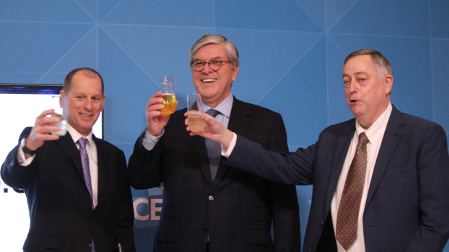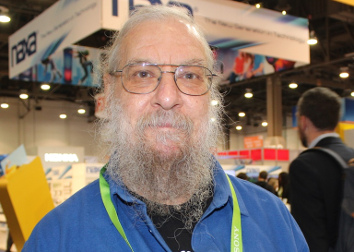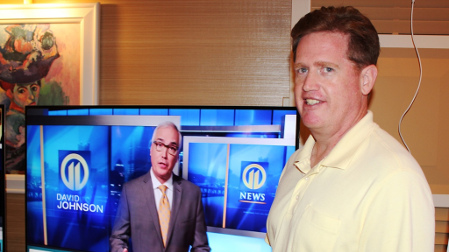CES 2018: ATSC 3.0 ‘Coming of Age’ Celebrated
LAS VEGAS—Although the weather outside the Las Vegas Convention Center was nothing short of frightful—more rain than anyone can remember in decades—this did nothing to dampen the spirits of scores of individuals who joined together inside to mark the delivery of the complete set of ATSC 3.0 DTV transmission standards. Mark Richer, president of the Advanced Television System Committee, was joined by Consumer Technology Association President and CEO, Gary Shapiro, and National Association of Broadcasters President and CEO, Gordon Smith in a 15-minute Consumer Electronics Show opening-day commemoration marking the event.

(L-R) Gary Shapiro, Gordon Smith, and Mark Richer offer a toast to the now-complete ATSC 3.0 DTV standard.
The ceremony—which had to be slightly delayed due to the weather-related late arrival of Shapiro—began with Richer’s praising the work of the individuals who helped to architect the new television broadcast standard.
“ATSC is very pleased to announce a major milestone today,” Richer began. “We’re celebrating the release of the complete suite of the ATSC 3.0 standard. This would not have been possible without the work of hundreds of individuals who spent tens of thousands of hours of their time in this five-year effort.”
In his remarks, Richer paraphrased the words of one of Winston Churchill’s World War II-era speeches.
“This is not the end; this is the end of the beginning,” he said, speaking with regard to the full rollout of the standard.
Richer also recognized that partnership of the consumer technology group and the NAB in bringing the standard to fruition. “ATSC 3.0 would not have been possible without industry collaboration—especially the collaboration of the NAB and CTA. It’s fitting that they are here to help celebrate this moment.”
Next on the platform was the NAB’s Smith, who was equally laudatory in his remarks.
“We have many people to thank for this ‘end of the beginning,’” said Smith. “Broadcasters now are the cornerstone partner in advancing this next chapter of broadcast television. And it is truly promising and remarkable, and there are so very many people to thank—certainly LG and Samsung and other television manufacturers who have stepped up to make this possible. We also want to thank the Pearl group, Sinclair, and so many others who have had this as a passion, and NAB enjoys this passion with them.”
Smith also saluted the FCC for their November decision to allow broadcasters to begin deploying ATSC 3.0.
“I want to thank the chairman and the other commissioners who [were] so central in providing this leadership so investment could occur and improvements could be offered for the future American viewer.”
The CTA’s Shapiro closed out the program by thanking the other organizations for their partnership in the effort and observing the significance of the moment.
“We’re celebrating a milestone today,” he said. “That’s a really big thing. [ATSC] 3.0 has now made it to deployment. The release is very significant.”
The ceremony concluded with a champagne toast to the successful completion of the standard.
WHERE ARE THE 3.0 TELEVISIONS?
With this event as prologue, one might imagine that CES exhibitors would also be touting the standard, and eager to show off their ATSC 3.0-capable television sets and other devices. This wasn’t the case however. An exhibition floor survey of all of the big-name TV manufacturers—and a number of lesser ones as well—revealed that 3.0 devices were not on display this year, despite several off-air demonstrations featured in recent years at the show.

Richard Chernock
Richard Chernock, one of the ATSC 3.0 committee members, and also chief technology officer at Triveni Digital, offered his thoughts on the absence of 3.0-driven devices.
“I think it might be a little bit on the early side,” said Chernock. “This year I expect to see [ATSC 3.0] broadcast happening. I expect to see it on the air. [However], consumer electronics manufacturers can’t really sell the TVs unless there are sources to watch. They’ve very concerned about returns, because there’s nothing to tune in. So, I think this year we’re going to see the broadcasters starting up—putting the signals on the air. I expect to see a lot of ATSC 3.0 at the CES next year.”
ATSC 3.0 IN THE AIR AND ON THE AIR IN LAS VEGAS
Despite the absence of ATSC 3.0 technology at the CES proper, demonstrations of the new standard were taking place just a few blocks away from the convention hall. Both the Sinclair Broadcast Group and Pearl TV set up shop in suites on the 37th floor of the Wynn Hotel to show off some of the features and functionality available with ATSC 3.0, as well as to discuss the evolution in television business models it may drive.
Mark Aitken, Sinclair’s vice president of advanced technology, and strong ATSC 3.0 promoter, was eager to describe the technology being shown in Sinclair’s suite.
“We’ve been engaged for the last two years with dozens of vendors in all areas of the ATSC 3.0 ecosystem to come up with a comprehensive cloud-based approach,” said Aitken. “We not only have storage, ingest, scheduling and playout all happening from the cloud, [but] it’s an end-to-end system.
“We’re demonstrating the ability to do ad insertion within the context of the ATSC standard. We have the ability to direct dynamic ads and services to different segments of viewers and consumers. We’re driving that across a complete ATSC 3.0 link with program guide. On the receiver side, we’re bringing together over-the-air with OTT with pre-positioned product. So the hybrid nature of ATSC 3.0 will be demonstrated as part of the consumer experience. Perhaps the most important piece is showing the ability to collect data and bring that data back into the front end of the system.
“The reason that we’re exhibiting at this show is that we believe that we have a launch strategy and a business strategy. If we just think of ATSC 3.0 as only better television, then we’ve lost all of the upside of 3.0. It’s so much more than just better television.”
Aitken noted that with the completion and acceptance of the ATSC 3.0 standard, the time for experimentation was over and the initiation of regular broadcast service had begun. He said that the goal of Sinclair and other ATSC 3.0 promoters is to get a number of full-time 3.0 stations on the air in 2018.
“We will be driving two dozen markets to light up in 3.0 this year.”

Sony’s Luke Fay explains the Pearl TV/Sony CES demonstration.
Just down the corridor from the Sinclair demo, ATSC 3.0 over-the-air television was on the air, albeit in a small way. Channel 20, licensed as station WM9XEH for the duration of the 2018 CES, was radiating a flea-power level ATSC 3.0 signal to multiple receiving devices as part of a Pearl TV/Sony Electronics joint venture to demonstrate the potential of 3.0, which includes interactive an on-screen program guide and enhanced content navigation capabilities. The demo is a prelude to a planned full-blown implementation in Arizona termed the “Phoenix model market project.”
According to Ann Schelle, Pearl TV’s managing director, this initiative will be “the first fully-compliant implementation of an ATSC 3.0 interactive environment.”
The project will involve 10 Phoenix-area TV broadcasters.
“This innovative platform will bring a state-of-the-are experience to the viewer, with interactivity, personalization and voice command support, both directly to the TV and indirectly through companion devices such as tablets and mobile phones,” said Schelle.
Luke Fay, senior manager of technology standards at Sony, was on hand to explain the technical setup used for the demonstrations, and to provide information about some of the advantages and features it could provide.
“The viewer can set filters such as ‘adult or child, food and dining, house and gardening, or travel or cars’ to provide choices in targeted advertising,” he said.
A second demonstration in the suite involved the coupling of a Google Alexa device with an on-screen program guide to allow a viewer to navigate through program choices without the use of a remote control.
For a comprehensive list of TV Technology’s ATSC 3.0 coverage, see our ATSC3 silo.
Get the TV Tech Newsletter
The professional video industry's #1 source for news, trends and product and tech information. Sign up below.
